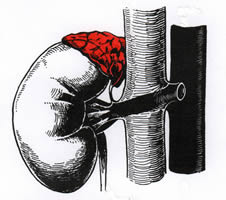Adrenal Glands
What are the adrenal glands?
 The adrenal glands are yellow triangular shaped glands at the top of your kidneys. They are normally about 2 to 3 cm in size. They produce a number of hormones such as cortisol, aldosterone, adrenaline and noradrenaline. These hormones are responsible for a number of functions including control of blood pressure and dealing with your body’s response to stress. The adrenal gland also manufactures some of the sex hormones.
The adrenal glands are yellow triangular shaped glands at the top of your kidneys. They are normally about 2 to 3 cm in size. They produce a number of hormones such as cortisol, aldosterone, adrenaline and noradrenaline. These hormones are responsible for a number of functions including control of blood pressure and dealing with your body’s response to stress. The adrenal gland also manufactures some of the sex hormones.
What are the indications for adrenal surgery?
Adrenal surgery (adrenalectomy) may be recommended where:
- There is a tumour of the gland. This is usually detected when a scan is performed for non-specific symptoms and an incidental tumour (adrenal incidentaloma) is detected. Most of these are benign but a small percentage turn out to be malignant (adrenal cancer) Surgery may be recommended if the tumour is large or causing symptoms.
- There is overproduction of hormones causing one of a number of clinical syndromes: Cushing's Syndrome is caused by excess secretion of cortisol, causing obesity and osteoporosis; Conn's Syndrome is caused by excess secretion of aldosterone which may cause problems with high blood pressure and blood potassium levels; Phaeochromocytoma leads to excess secretion of adrenaline and noradrenaline causing problems such as high blood pressure, excess sweating, tremor, and anxiety.
How is adrenal surgery usually done?
Adrenalectomy can be done as an open procedure or as a laparoscopic (keyhole) procedure.
Open adrenalectomy
 This is usually performed if the adrenal tumour is very large or is likely to be a cancer. Open adrenalectomy is generally performed under a general anaesthetic. Open operations may be performed through the back, the flank, or the abdomen. In all cases a skin incision is made and the underlying muscles divided. The adrenal gland is located and removed with great care being taken not to injure nearby structures such as the major veins in the abdomen. The muscles are then put together again and the skin incision is closed with sutures that will either absorb or be removed soon after your operation.
This is usually performed if the adrenal tumour is very large or is likely to be a cancer. Open adrenalectomy is generally performed under a general anaesthetic. Open operations may be performed through the back, the flank, or the abdomen. In all cases a skin incision is made and the underlying muscles divided. The adrenal gland is located and removed with great care being taken not to injure nearby structures such as the major veins in the abdomen. The muscles are then put together again and the skin incision is closed with sutures that will either absorb or be removed soon after your operation.
Laproscopic adrenalectomy
This can be performed where the tumour is smaller and unlikely to be a cancer. It is also performed under general anaesthetic. Laparoscopic procedures use small telescopes and instruments to remove the adrenal gland through a number of small incisions. The adrenal gland is located and removed with video guidance and, as with open surgery, with great care being taken not to injure nearby structures such as the major veins in the abdomen. Typically, patients having laparoscopic procedures have less pain and a more rapid recovery.
What are the risks and complications of adrenal surgery?
Most surgery nowadays is safe however any operation has general risks including reactions to the anaesthetic, chest infections, blood clots, heart and circulation problems, and wound infection. In addition there are specific risks associated with adrenal surgery as follows:
- Bleeding may occur during the operation as the adrenal glands are near large arteries and veins. This may lead to the need for a blood transfusion.
- Abnormally high or low blood pressure is a risk following removal of some adrenal tumours. This can usually be prevented or treated with medicine.
- Any open surgical incision in the abdomen may be at risk of developing a hernia long after the operation.
- Depending on the type of adrenal disorder leading to your adrenalectomy, you may require oral steroid medication to replace those steroids formerely made by the adrenal gland. In some cases, these steroids are essential for life.













